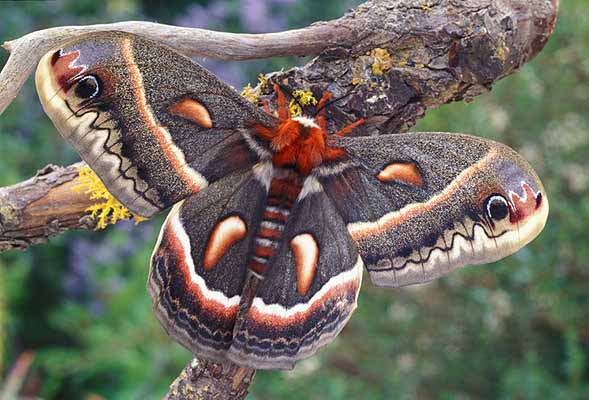
Hyalophora cecropia (Hyalophora cecropia)
Phylum — arthropoda
Class — insecta
Order — lepidoptera
Family — saturniidae
Genus – hyalophora
Appearance
The first instar larvae are black. Their coloration is due to small black hairs growing from tubercles (small projections) all over their body. As the caterpillars grow larger into the second larval instar, they become yellow green. During the third, fourth, and fifth instars, the butterfly becomes rather large and bluish green. At these final stages, the tubercles become blue, yellow or orange, depending on location on the body, while the black hairs are eventually lost.
Wing span: 4 5/16–5 7/8 inches (11–15 cm). Body is red with a white collar and white bands on the abdomen. Wings are dark brown with white hairlike scales giving a frosted appearance; forewings are red at the base. Crescent spots and the area outside the postmedian line are red on all wings. Hyalophora cecropia is the largest moth found in North America.
Habitat
These moths can be found all across North America as far west as Washington and north into the majority of Canadian provinces.
Behavior
Butterflies are active from 3 a.m. until sunrise. Butterflies overwinter in the pupa stage. The younger caterpillars live in groups, the older ones – alone.
Hyalophora cecropia moths are univoltine, having only one generation per year.
Diet
Hyalophora cecropia larvae are most commonly found on maple trees, but they have also been found on cherry and birch trees among many others.
The adult moths don’t eat at all.
Reproduction
For their reproduction you need a mesh terrarium with a size of 70 x 70 x 90 cm. Females lay rows of 2-6 eggs on both sides of the leaves of small host trees. These eggs are a mottled reddish brown. Eggs hatch in 10-14 days. Incubation at a humidity of 70-80% and a temperature of 22-24°C. It is best to grow the caterpillars in natural conditions and place them in a mesh sleeve that is attached to the branch of a tree growing on the street. You should not keep many caterpillars together. They are very susceptible to viral and bacterial diseases at all stages of development. The caterpillar develops for 2-3 months. The caterpillar then makes a cocoon by attaching it to a twig. The cocoon is brown. It is advisable to introduce the pupae into diapause by placing the cocoon in the basement for 2-3 months. You can also put the cocoons in the refrigerator, moistening them every two weeks. The cocoon is able to withstand temperatures up to - 40 oC. The butterfly's life span is 14 days.
In captivity
The mesh terrarium with a size of 70 × 70 × 90 mm is suitable for keeping butterflies. Room temperature is necessary.
 Russian
Russian
 English
English























